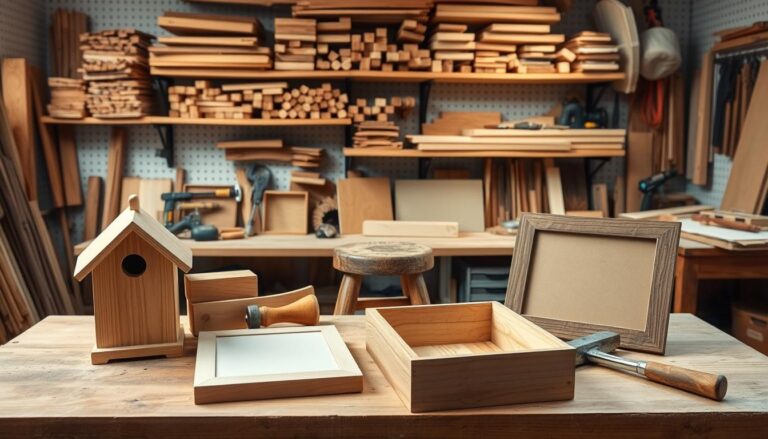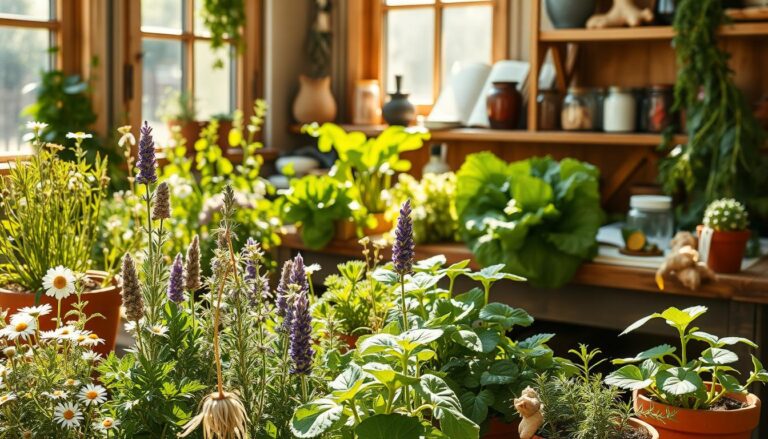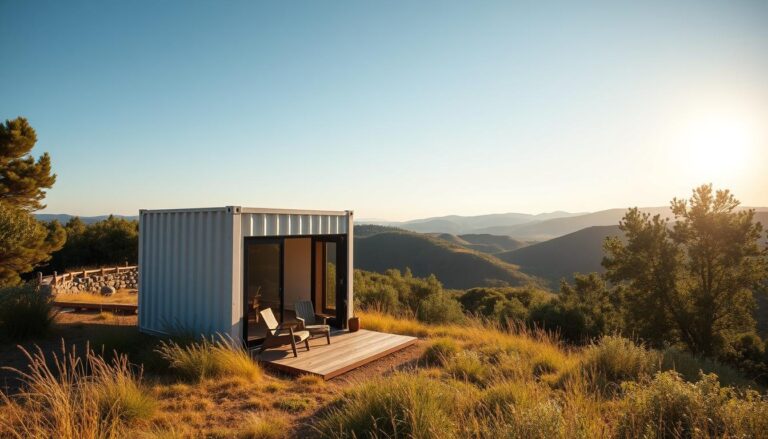Home Vegetable Gardening Fed My Family and Saved My Sanity
Discover how home vegetable gardening can nourish your family and become a delightful, stress-relieving hobby with our easy-to-follow guide.
I felt really overwhelmed. Work, family, and stress were taking a toll. Then, I found a DIY project that changed everything: home vegetable gardening. It became a way to feed my family and find peace.
I was a bit skeptical at first. My backyard didn't look like the perfect gardens online. But, the pandemic made food expensive. Gardening seemed like a smart way to save money and eat healthy.
As time went by, I saw how much this project could change us. Watching seeds grow into plants was amazing. Our garden gave us fresh food and a place to relax.
My kids loved helping with the garden. It brought us together. Every time we picked a vegetable, we celebrated our hard work. Gardening became a big part of our lives.
Key Takeaways
- Starting a home vegetable garden can be a fulfilling DIY home project.
- An effective way to enhance family nutrition with fresh, organic produce.
- Gardening provides excellent stress relief activities.
- Embracing a self-sufficiency mindset can have numerous benefits.
- Getting your family involved makes the gardening experience even richer.
Introduction to Home Vegetable Gardening
Starting a home vegetable garden is fun and healthy. It's more than a hobby. It brings joy, accomplishment, and fresh food to your table.
Why I Started a Home Vegetable Garden
I wanted to control the food my family eats. Growing our own food is rewarding. It's free from bad chemicals and full of care. 🌱
Fresh tomatoes and crisp greens made our meals better. Even weird-shaped carrots were fun.
Benefits of Home Vegetable Gardening
Gardening is good for more than just food. It makes us eat more veggies, which is healthy. It also saves money and gets us moving.
Gardening is calming. It helps us relax and feel proud of our work. Have you noticed how plants make you feel better? 🌞
Gardening brings families together. It teaches kids responsibility and builds community. You can garden anywhere, big or small.
Planning Your Vegetable Garden
Starting a vegetable garden can seem hard. But with some planning, you can make a great garden. It doesn't matter if you're new or experienced. Making good choices early helps your garden grow well.
Choosing the Right Location
Choosing the right spot for your garden is key. Look for a place that gets 6-8 hours of sunlight a day. Vegetables need sunlight to grow well.
Also, make sure the spot drains well. You don't want water to pool and hurt your plants' roots.
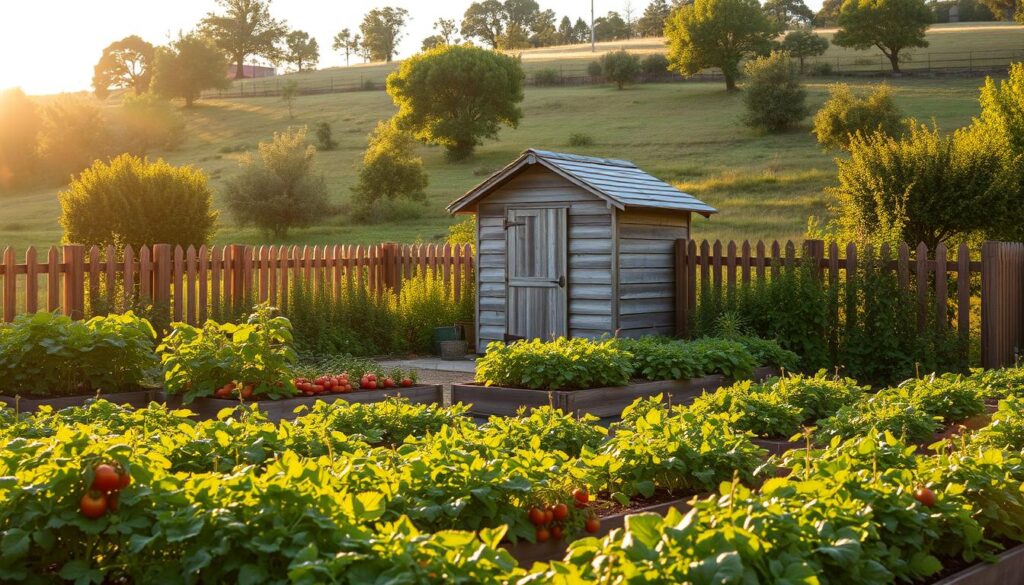
Soil quality is very important. Test your soil to see what it's like. Most veggies like soil that's well-drained and has a pH of 6.0 to 7.0.
If your soil isn't right, add compost or other organic stuff. This will make your soil better for your plants.
Selecting the Right Vegetables
Picking the right veggies is very important. Start by choosing ones that fit your local climate. Check with local gardening experts or the USDA Plant Hardiness Zones to find out what grows best in your area.
Space is often a problem in home gardens. Pick veggies that don't take up too much room. Also, think about planting some together to help each other grow better. For example, basil and tomatoes taste better together and keep pests away.
Plan your garden with the seasons in mind. Plant cool-season veggies like lettuce and spinach in spring or fall. Plant warm-season veggies like tomatoes and peppers after the frost is gone.
“The best way to choose the right vegetables is to grow what you and your family love to eat. This way, your gardening efforts will be both rewarding and gratifying.”
- Evaluate sunlight availability
- Check soil quality and drainage
- Opt for climate-suitable vegetables
- Utilize companion planting strategies
Remember, good gardening takes planning. Whether it's picking the right spot or choosing veggies, enjoy the process. Your garden will thank you with lots of fresh food.
Getting Started with Small Space Vegetable Gardening
Do you think you can't have a vegetable garden because of limited space? Think again! Small space gardening can be a game-changer. It's perfect for urban dwellers who want to grow fresh produce easily and efficiently.
Maximizing Your Available Space
First things first, let's get creative with the space we have. Small spaces need smart solutions. Here are some tips:
- Vertical Gardening: Use trellises or wall planters to grow plants upwards.
- Hanging Baskets: Perfect for herbs and small vegetables like cherry tomatoes.
- Window Boxes: Utilize window sills for a sunny spot to grow lettuce or radishes.
These methods make the most of your space. They give your plants enough room to grow. Want to see how container gardening plays a vital role?
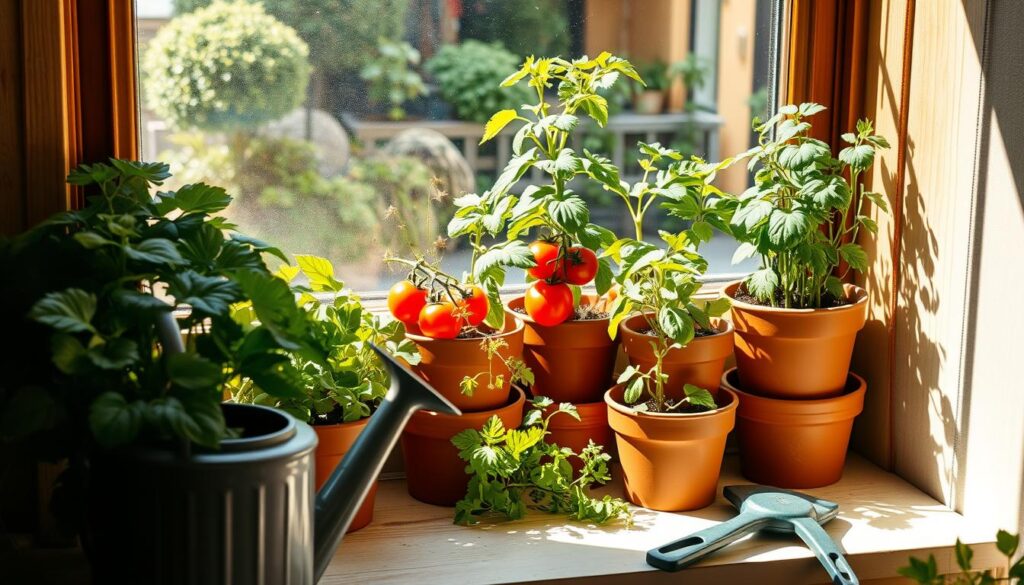
Container Gardening Basics
Container gardening is a great urban gardening solution. Here are the basics to get you started:
- Choosing Containers: Select containers with good drainage. Options range from ceramic pots to reused buckets.
- Soil Type: Use high-quality potting mix that can retain moisture without waterlogging the roots.
- Plant Selection: Opt for dwarf or compact vegetable varieties that thrive in containers. Tomatoes, peppers, and spinach are excellent choices.
Maintaining plant health is equally important. Regular watering, fertilizing, and ensuring adequate sunlight are critical to successful small space gardening.
Ready to transform that tiny balcony into a lush green haven? With these urban gardening solutions, you're all set to enjoy a bountiful harvest, regardless of your limited space!
Indoor Vegetable Gardening: Growing All Year Round
Want to keep gardening all year? Indoor vegetable gardening lets you grow food inside. You get fresh produce anytime, without going outside. Let's look at what you need to start and the best veggies to grow indoors.
Essential Tools and Equipment for Indoor Gardening
To start indoor gardening, you need some basic tools. Here's what you'll need:
- Grow lights: These mimic sunlight, giving plants 6-8 hours of light daily.
- Pots and containers: They should have holes for water to drain.
- Proper soil: Use good potting soil for indoor gardening to feed your plants.
- Fertilizers: Feed your plants every 2 weeks to once every 3 to 4 months.
- Watering can: Water plants regularly, letting soil dry 1-2 inches before watering again.
Choosing the Best Indoor Vegetable Varieties
Not all veggies grow well indoors. Pick the right ones for your garden:
- Herbs: Basil, parsley, cilantro, chives, oregano, mint, and rosemary grow well indoors. They add fresh taste to your food.
- Carrots: Choose small varieties. They need 4-5 hours of sunlight and take 40 days to grow.
- Peppers: They need 10 hours of sunlight and take 60 to 150 days to grow.
- Salad greens: Perfect for indoors, needing moist soil and 12 hours of light. Microgreens are ready in 14 days, while baby greens take 3 to 4 weeks.
- Radishes: They need 6-8 hours of sunlight and grow in 30-45 days.
- Scallions and garlic greens: These perennials grow continuously, great for year-round gardening.
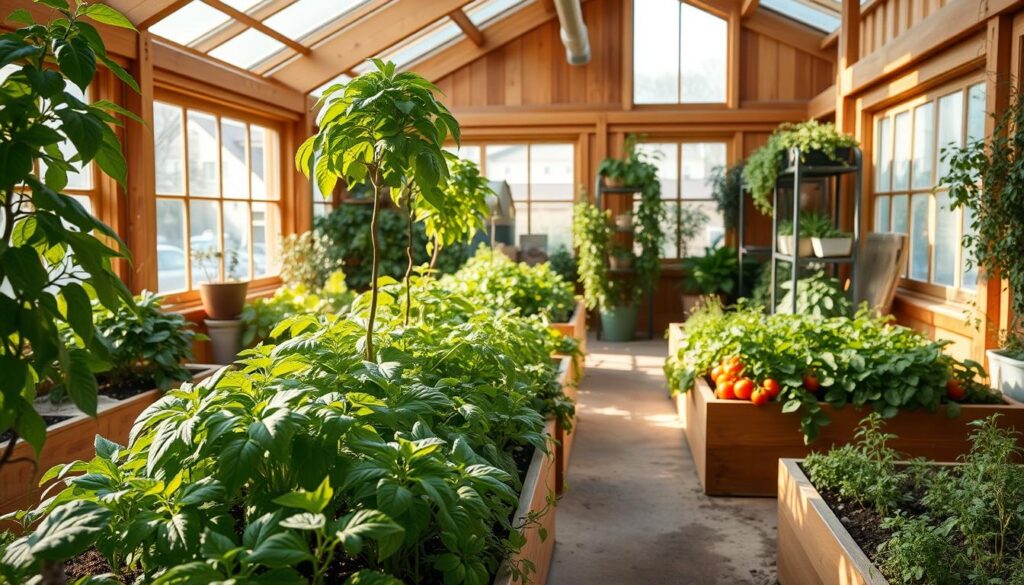
With the right tools and the right veggies, you'll enjoy fresh produce all year. Start this rewarding hobby and see your hard work grow!
Essential Beginner Home Gardening Tips
Starting a home garden can feel overwhelming. But with a few basic tips, you can create a thriving green space. Let's dive deep into the essentials. 🌿
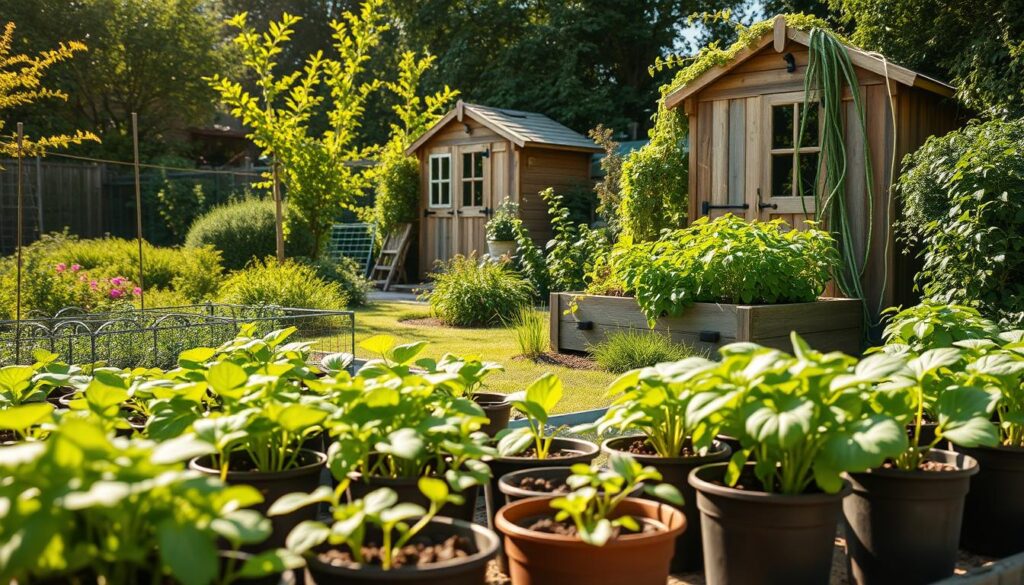
Preparing the Soil
Soil preparation is key. Without good soil, plants won't grow well. Start by removing weeds and debris. This step is very important. 🛠️
Next, test the soil. Many garden centers sell simple soil test kits. These kits help you know the soil's pH levels and nutrient content.
Here are a few steps to improve soil quality:
- Mix compost or aged manure into the soil. This boosts nutrient levels and improves soil structure.
- Add organic matter such as chopped leaves or grass clippings.
- If the soil is too clayey, mix in sand to improve drainage.
Basic Planting Techniques
Ready to plant? Starting seeds indoors is a great idea. It gives your plants a head start. Once they're strong, you can transplant them into the garden.
For direct sowing, place seeds at the proper depth as mentioned on the seed packet. A little trick I've learned: water the soil before planting the seeds to help them settle in faster.
Maintaining Your Garden
Once your plants are in the ground, gardening maintenance is key. This means regular watering, weeding, and monitoring for pests. I recommend watering in the early morning to reduce evaporation.
Keep an eye out for yellowing leaves – it might be a sign of pests or nutrient deficiency. 🧐
Consistent care will keep your garden lush and productive. Here's a quick checklist:
- Water consistently but avoid waterlogging.
- Mulch around plants to retain moisture and reduce weeds.
- Prune dead or diseased leaves regularly.
If you follow these tips, your gardening journey will surely be fruitful. Happy gardening! 🌸
Organic Home Gardening Practices
Ever wondered why organic gardening is so popular? It's not just about growing plants. It's about making a garden that's good for the earth. Organic gardening makes the soil better, helps many different plants live together, and makes sure your food is healthy.
Benefits of Organic Gardening
Organic gardening is great for the earth and for us. Here are some big reasons to try it:
- Soil Health: Using compost instead of chemicals makes the soil better.
- Safe Produce: No bad pesticides means your food is safer to eat.
- Biodiversity: Organic gardens are homes for good bugs and animals.
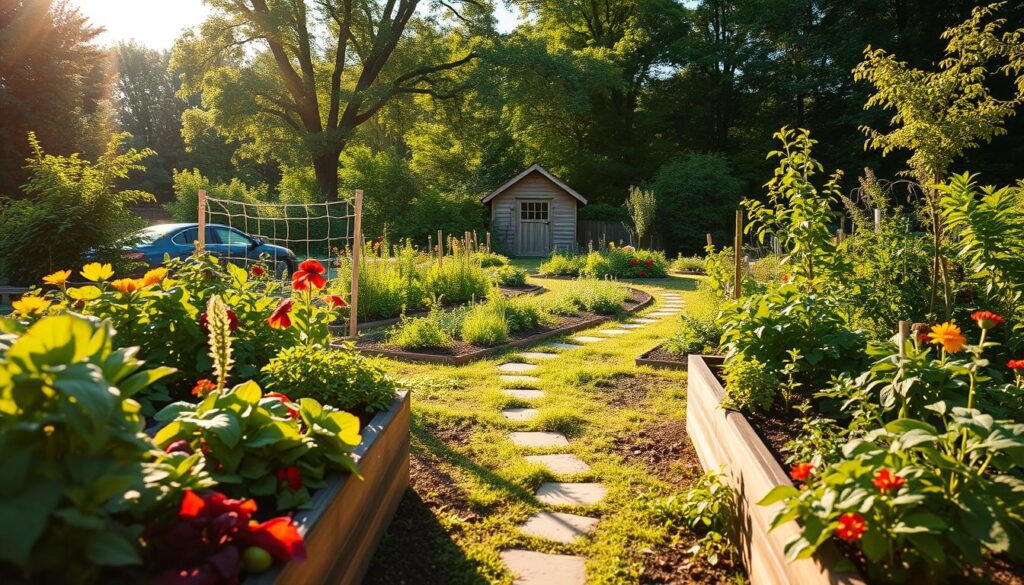
Natural Pest Control Methods
Keeping pests away without chemicals is possible. Here are some ways to do it:
- Companion Planting: Some plants, like marigolds and basil, keep pests away.
- Neem Oil: This natural spray is good for many pests and is safe for people and pets.
- Diatomaceous Earth: A powder that stops slugs, snails, and other bugs.
Using these methods makes gardening organic and good for the planet. Your garden will do well, and you'll feel happy knowing you're helping nature.
Urban Home Gardening: Overcoming Space Limitations
Urban gardening has its own set of challenges. But it can also be very rewarding. One big challenge is the lack of space. But, you can solve this with creative gardening solutions like container gardening, rooftop gardens, and vertical walls.
Compact gardening designs are great for city folks who want a green space. You can use vertical gardening with trellises and hanging planters. This turns even the smallest balcony into a green oasis. Rooftop gardens let you grow lots of plants, from veggies to flowers.
Have you thought about joining a community garden? It's a great way to share space and meet others. Hydroponic systems are also popular. They let you garden without soil, right in your apartment. These systems help you grow food efficiently.
For urban gardening fans, facing space limits is part of the fun. By using compact gardening designs and creative solutions, you can make cities green and lively. Why not try it and see how a small space can grow? 🌱
How the DIY Project Improved Our Family’s Health
Starting our own garden gave us many health benefits of gardening. It changed our family's health in big ways. How did it make our lives better?
Increased Vegetable Consumption
We ate more fresh vegetables after starting the garden. Getting kids to eat greens was hard before. Now, it's a joy! Eating our own veggies was tasty and full of nutrients.
Health Benefits of Fresh Produce
Eating more fresh veggies made us feel better. We had more energy, better digestion, and clearer minds. The boys loved meals more because they knew where the food came from.
Gardening became a family activity that helped us relax. It reduced stress and made our home feel calmer. Who knew our DIY project would improve our health so much?
Saving Money with Home Vegetable Gardening
Gardening at home is more than a hobby. It's a smart way to save money and get a good return on investment. Wondering how much you can save? Let's look at the numbers and a simple way to plant vegetables seasonally!
Comparing Costs: Grocery Store vs. Homegrown
Imagine getting fresh produce from your backyard instead of the store. Buying vegetables can cost a lot over a year. Growing your own can save you a lot of money.
| Item | Grocery Store Cost | Homegrown Cost |
|---|---|---|
| Tomatoes | $2.50/lb | $0.50/lb |
| Zucchini | $1.80/lb | $0.30/lb |
| Lettuce | $1.50/head | $0.20/head |
Seasonal Planting to Maximize Savings
Using seasonal planting ensures a big harvest and a green garden. Planting in the right season means less need for greenhouses or expensive pest control. Here are some seasonal planting tips:
- Spring: Lettuce, spinach, peas
- Summer: Tomatoes, cucumbers, beans
- Fall: Broccoli, cauliflower, kale
Are you ready to start saving money with gardening? It's not just about the fresh food. You'll also see your monthly budget improve. Let's start planting and see the gardening ROI for ourselves!
Creating a Sustainable Home Gardening Routine
Starting a sustainable gardening routine can make gardening fun. It helps your garden grow and makes you feel good. But, how do you keep up with it? Let's find out!
Begin with small steps. Trying too much at once is hard. Focus on simple tasks like watering or weeding. This makes gardening easier.
Set aside time each week for gardening. It's like your own special time. This makes gardening a calm activity, not a chore.
- Watering in the early morning.
- Weeding every Wednesday.
- Harvesting and pruning on weekends.
Keep a gardening journal to track your progress. Write about changes, challenges, and successes. It helps you stay on track and learn from your experiences.
| Task | Frequency |
|---|---|
| Watering | Daily |
| Weeding | Weekly |
| Harvesting | Bi-weekly |
Involve your family in gardening. It makes it more fun and less work. It's also a great way to teach kids about nature. Are you ready to make gardening a regular part of your life? 🥕🌱
Medicinal Garden Kit
Have you thought about making a healing garden in your backyard? It's easy and great for using *medicinal plants* in home remedies.
Imagine picking fresh herbs for your teas and treatments. A medicinal garden kit can have plants like chamomile and peppermint. These are easy to grow and useful for health.
“Growing your own medicinal plants not only enhances your health but also brings you closer to nature.”
Why not start with some basics? Here's a simple guide for your healing garden:
- Chamomile – Perfect for soothing teas and stress relief.
- Peppermint – Great for digestion and respiratory health.
- Lavender – A calming herb used in aromatherapy and skin care.
- Echinacea – Known for boosting the immune system.
For more help, a *medicinal garden kit* is a good choice. These kits have seeds, pots, and instructions. Soon, your *healing garden* will grow, giving you natural remedies.
| Plant | Health Benefit | Usage |
|---|---|---|
| Chamomile | Stress Relief | Tea |
| Peppermint | Digestion | Tea, Essential Oil |
| Lavender | Calming | Aromatherapy, Skincare |
| Echinacea | Immune Support | Herbal Remedies |
Ready to make your healing oasis? Start using *medicinal plants* for a healthier life. 🌿
Conclusion
Looking back, home vegetable gardening has been very impactful. Choosing the right spot and veggies was key. We learned to garden in small spaces and indoors too.
Growing our own food saved money and kept us healthy. It also helped control pests naturally. These benefits are priceless.
Gardening has made us eat more veggies and feel better. It brought us joy and made our family closer. Harvesting our own food is incredibly rewarding.
It shows us where our food comes from and how it's grown. These gardening benefits keep us motivated to garden more.
If you're thinking about starting a garden, now is the time. You don't need a big yard to grow veggies. Even a small balcony can work.
So, get some seeds and start gardening. It's a journey full of satisfaction and benefits. Begin your gardening adventure today!


